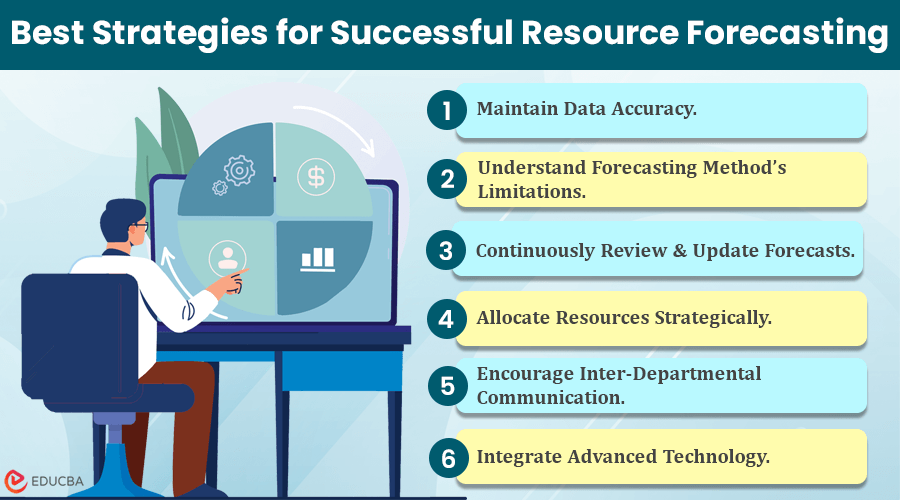
What is Resource Forecasting?
Resource forecasting lets companies estimate the quantity and type of resources they might need in the future to achieve their business objectives. These resources include physical and non-physical factors, such as staff, employees, time, equipment, and software needed to complete the project.
Moreover, resource forecasting examples offer valuable insights to project managers for estimating future resource needs accurately and optimizing resource utilization. Thus, it has now become an integral part of modern business practices.
Table of Contents
Practical Examples of Resource Forecasting in Modern Businesses
Every business, regardless of its size or type, benefits from resource forecasting, such as.
- A manufacturing company uses resource forecasting to calculate the raw materials needed to meet production targets.
- A retail store uses it to determine the number of staff members required during peak sales hours.
- Furthermore, tech companies rely on it to anticipate future technological (software) needs to allocate the necessary funds.
- In the construction industry, this forecasting is essential to prevent duplication and wastage in allocating materials, workforce, and machinery.
- On the other hand, hospitals apply it for staff scheduling, ensuring the right number of healthcare experts are available for each shift.
Resource Forecasting Techniques
Industry leaders use various techniques for forecasting resources. However, the choice of technique would depend on the business’s objectives, available data, and industry nature.
Here are some common resource forecasting techniques:
1. Time Series Analysis
Time series analysis involves using historical data to predict future resource needs. This technique works best when the data has clear patterns and trends.
2. Causal Models
Causal models help understand the relationship between an organization’s activities and resource requirements. For example, regression analysis is a common model that identifies statistical relationships between variables.
3. Qualitative Methods
Qualitative methods, such as expert judgment and the Delphi technique, rely on the opinions of industry experts and stakeholders to predict an organization’s resource needs. However, this method is particularly useful when there is limited historical data or the business environment changes rapidly.
How to Master the Art of Resource Forecasting?
This forecasting is not a one-size-fits-all process, but there are common steps that any business can follow. The following is a step-by-step guide to mastering the art of resource forecasting.
1. Set the Period
The process begins with defining the forecast horizon or the future period. It is basically the duration that you want to predict the resource allocation for.
2. Collect and Analyze Data
The next step is to collect and analyze relevant historical data. It includes data on past resource usage, business activities, and external factors such as market trends or economic conditions. You can also use this data to identify patterns and trends to gain valuable insights.
3. Apply Forecasting Techniques
Once you have gathered and analyzed the data, apply forecasting techniques to predict future resource demand. Moreover, choosing a technique that best fits the business’s unique requirements and circumstances is essential.
4. Regularly Review and Update Forecast Data
Finally, regularly review and update forecast data based on changing business needs and external conditions. It ensures that the data remains relevant and accurate in your business environment over time.
Best Strategies for Successful Resource Forecasting
The following are some strategies businesses can use for optimal results.
1. Maintain Data Accuracy
Businesses should maintain data accuracy to excel in forecasting resources. It ensures that forecasts are reliable and trustworthy.
2. Understand the Limitations of Forecasting Methods
Businesses should understand the strengths and weaknesses of their chosen forecasting methods. It helps them to make better decisions and predictions.
3. Continuously Review and Update Forecasts
Businesses must also continuously review and update their forecasts. It will help them to make relevant and responsive changes in their business operations.
4. Allocate Resources Strategically
Companies should also allocate current resources thoughtfully and strategically. Unnecessarily overbudgeting for certain resources can lead to inefficiency and decreased profitability.
5. Encourage Inter-Departmental Communication
Inter-departmental communication is equally important. Sharing forecasting insights across departments promotes informed decision-making and enhances overall operational efficiency.
6. Integrate Advanced Technology
Lastly, businesses should use technology and take advantage of forecasting software. These tools offer automation, accuracy, and efficiency, making the forecasting process simpler and more effective.
Final Thoughts
Overall, resource forecasting is a vital tool for strategic planning and crucial for any organization’s success. By understanding and properly implementing its techniques, businesses can better prepare for the future and maximize their resources.
Recommended Articles
We hope this article on resource forecasting was beneficial to you. To learn more about related topics, refer to the articles below.
